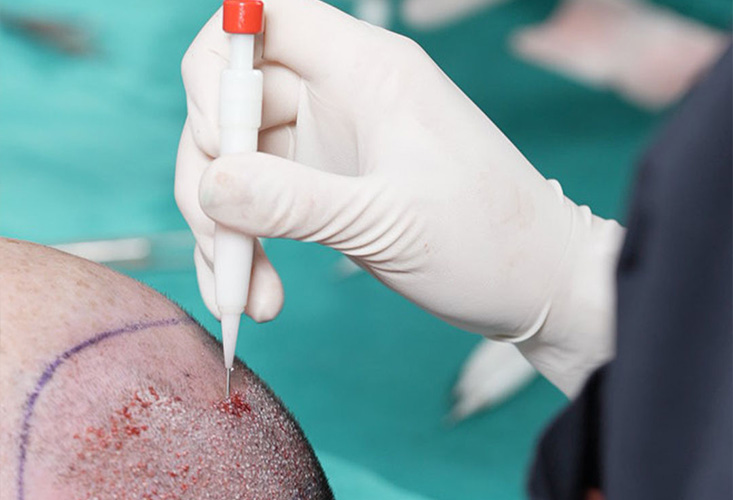Après avoir subi une procédure de greffe de cheveux, la peau entre dans une période très sensible. Cette sensibilité est principalement causée par l'opération pratiquée dans la zone de transplantation, ce qui se traduit par un inconfort minimal pour la peau. Le processus de cicatrisation de la peau commence progressivement entre le 1er et le 4ème mois. La durée et l'intensité des rougeurs cutanées après une greffe de cheveux varient d'une personne à l'autre. Toutefois, les personnes à la peau sensible et claire ont tendance à ressentir une plus longue durée de rougeurs, ce qui semble plus important. En revanche, les personnes dont la peau est plus foncée peuvent ne pas ressentir autant de rougeurs. Les rougeurs sont considérées comme une condition normale, quel que soit le teint de la peau. En particulier, les rougeurs sont généralement moins fréquentes dans les opérations réalisées à l'aide de la technique DHI. La micro-pigmentation est un processus similaire à un tatouage appliqué sur la peau pour créer l'apparence des cheveux dans une zone spécifique avec des lignes qui ressemblent à des racines de cheveux naturelles. Il est important de noter que la micro-pigmentation peut s'estomper ou devenir moins visible avec le temps. On sait également que dans certains cas, l'application d'une micropigmentation sur les zones transplantées un an après la greffe de cheveux peut augmenter la densité. Il est crucial de comprendre que la greffe de cheveux et la micropigmentation sont deux procédures distinctes. La greffe de cheveux est un processus complètement différent qui vous permet de façonner, d'allonger et de coiffer vos cheveux avec vos cheveux d'origine. Il est recommandé que toutes les personnes admissibles se soumettent à cette procédure, car les résultats les plus attrayants et les plus authentiques sont obtenus uniquement grâce à la greffe de cheveux. Les personnes ayant un faible nombre de follicules dans la zone donneuse et une grande zone de calvitie devraient envisager la micropigmentation en plus de la greffe de cheveux pour obtenir une densité complète. Le processus de greffe de cheveux a été amélioré et modernisé avec les derniers appareils technologiques disponibles aujourd'hui. L'un de ces appareils est l'appareil d'anesthésie sans aiguille, qui est utilisé pour l'anesthésie pendant la greffe de cheveux. En remplissant l'anesthésique dans un dispositif et en l'injectant dans les terminaisons nerveuses de la zone donneuse avec pression, sans l'utilisation d'une aiguille, la douleur peut être réduite jusqu'à 80% par rapport à l'ancienne technique, permettant une application plus confortable de l'anesthésique lors de la greffe de cheveux. Cependant, le seuil de douleur pendant le processus d'anesthésie avant la greffe de cheveux peut varier d'une personne à l'autre, car il est ressenti différemment par chaque individu ; Certaines personnes ressentent une douleur intense tandis que d'autres ne ressentent aucune gêne. Un autre type de procédure d'anesthésie est la sédation, qui implique l'utilisation de médicaments sédatifs pour endormir la personne pendant une courte période. La personne ne se souvient pas de l'anesthésie et ne ressent aucune douleur. Lors d'une opération de greffe de cheveux, un sérum léger est injecté dans la peau pour réduire les saignements dans la zone à transplanter et pour élargir la surface permettant de planter facilement les greffons dans la zone unitaire. Cependant, il est important de noter que ce sérum injecté peut se déplacer vers le bas en raison de la gravité et peut descendre vers le front et le visage de la personne. Cette situation se produit souvent. Alors que moins de liquide est utilisé dans la technique de greffe de cheveux DHI, plus de liquide est nécessaire dans la technique Sapphire FUE. La liste des médicaments à utiliser après l'opération pour l'enflure comprend un médicament pour l'enflure. L'enflure commence généralement le deuxième jour après l'opération et disparaît le cinquième jour, selon le médicament utilisé et la façon dont vous suivez les instructions. Le gonflement après une greffe de cheveux n'a pas d'impact direct sur la santé du corps ou la santé des cheveux, Il ne cause pas non plus de tort. Il n'en résulte qu'un aspect gonflé pendant 2 à 3 jours après l'opération. La greffe de cheveux est une procédure sûre qui ne présente aucune menace pour la santé humaine. Les effets secondaires temporaires qui surviennent après la chirurgie sont maintenant considérés comme faisant partie de la procédure et disparaissent généralement dans les 10 jours. Le processus n'implique aucune modification chimique. Le seul problème est la cicatrice qui reste dans la zone donneuse, qui prend la forme de minuscules points blancs. Cependant, cette cicatrice peut être déguisée en laissant des cheveux légèrement plus longs dans la zone donneuse. Le nombre de greffons dans la greffe de cheveux est une situation variable qui est complètement différente pour chacun. Il est directement proportionnel au nombre de racines dans la zone donneuse et dépend de la surface requise. Plus la zone donneuse de la personne est bonne et plus la qualité des racines est élevée, plus le nombre de racines augmentera. Si un résultat de greffe de cheveux sain est souhaité, un maximum de 5500 greffons peuvent être transplantés en une seule séance, selon la situation. Bien qu'il soit possible de transplanter plus de greffons, laisser les racines extraites à l'extérieur pendant une période prolongée peut entraîner une réduction du taux de croissance des racines qui pousseront après la transplantation. La greffe de cheveux permet aux individus d'avoir leurs cheveux d'origine dans la forme souhaitée pour toute une vie. L'entretien, le coiffage et les soins sont naturels et faciles. Si une personne a un nombre suffisant de greffons dans la zone donneuse, ils doivent absolument envisager une opération de greffe de cheveux. Il serait illogique pour quelqu'un qui est un bon candidat pour une greffe de cheveux de choisir une perruque. Le port d'une perruque est une procédure entièrement artificielle et non naturelle. Il peut être difficile à utiliser, coûteux, et difficile à entretenir. De plus, l'attachement de la perruque au cuir chevelu peut, au fil du temps, endommager la peau, interférer avec la circulation sanguine, et empêcher l'exposition au soleil et à l'oxygène, qui sont essentiels pour des cheveux sains. La greffe de cheveux est généralement considérée comme autorisée, car elle implique l'utilisation de ses propres cheveux et n'est pas spécifiquement abordée dans les enseignements islamiques. L'idée qu'il n'y a rien de mal à subir une greffe est étayée par l'absence d'interdictions spécifiques dans le Coran ou les Hadiths, combinée au principe du maintien de la santé et de l'apparence dans les limites islamiques. Cependant, il est conseillé aux individus de consulter des érudits islamiques bien informés pour s'assurer que leur situation spécifique est conforme aux principes et à l'éthique islamiques. Pour obtenir une greffe de cheveux d'apparence naturelle, la chirurgie doit être réussie et la qualité des racines transplantées doit être modérée à élevée. Plusieurs paramètres doivent être réunis pour obtenir un résultat de greffe de cheveux de qualité et d'apparence naturelle. Les deux facteurs les plus cruciaux sont la qualité des racines de la personne et l'expérience du médecin et de l'équipe qui effectue l'opération. En plus de ces considérations, l'obtention d'un résultat naturel optimal nécessite l'utilisation d'outils avancés tels que les lasers, les échelles millimétriques et les microscopes. Bien que le risque de rejet de la greffe de cheveux soit extrêmement faible en raison de l'utilisation de vos propres greffons, il est essentiel d'être conscient des risques et des complications potentiels associés à la procédure. Bien que le rejet soit rare, d'autres problèmes tels que l'infection, des saignements, des cicatrices et des résultats esthétiques insatisfaisants doivent être pris en compte. Pour minimiser le risque de complications, il est essentiel de choisir un chirurgien qualifié et expérimenté et de suivre les instructions de soins postopératoires. Au cours du processus de consultation, il est essentiel de discuter de toute préoccupation ou question, y compris la possibilité que les cheveux ne poussent pas après la transplantation. Les cheveux greffés qui ne poussent pas sont souvent attribués à des déséquilibres hormonaux et à des carences en vitamines. Une approche bien informée et proactive peut contribuer à une expérience de greffe de cheveux réussie.Qu'est-ce qui cause un cuir chevelu rouge après une greffe de cheveux ?
Greffe de cheveux ou micropigmentation - quelle est la meilleure option ?
La greffe de cheveux est-elle douloureuse ?
Pourquoi y a-t-il un gonflement après une greffe de cheveux ?
Quels sont les effets secondaires à long terme de la greffe de cheveux ?
Combien de greffes de cheveux peut-on transplanter en une seule séance ?
Qu'est-ce qui est le mieux, une greffe de cheveux ou une perruque ?
La greffe de cheveux est-elle interdite dans l'islam ?
Toutes les greffes de cheveux ont-elles l'air naturelles ?
Est-il possible que votre corps rejette les cheveux greffés ?
Tout ce que vous devez savoir sur les greffes de cheveux : effets secondaires, processus et préférences



 Deutsch
Deutsch
 English
English
 français
français
 italiano
italiano
 Türkçe
Türkçe
 русский
русский
 한국어
한국어

